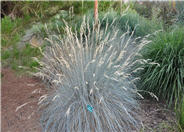
Common name:Blue Oat Grass
Botanical name:Helictotrichon sempervirens
Blue oat grass is a striking ornamental grass with blue foliage and a clumping habit. It grows 12 to 18 inches tall and wide. Its showy flowers are 1 to 2 feet above the foliage. Is evergreen in mild winters. This plant looks good alone as well as in mass plantings. The blue oat grass likes dry hill sides and is drought tolerant.
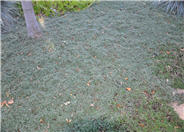
Common name:Woolly Thyme
Botanical name:Thymus lanuginosus
Woolly Thyme is a perennial groundcover growing in a low mat, typically under 2 inches, but spreading 16 inches or more. Foliage is fuzzy and gray-green during the summer months, and tinged with a lovely burgundy hue in the fall and winter. An evergreen thyme, it makes a wonderful groundcover, even an alternative to turf, in low traffic areas. And as it tolerates some foot traffic, its wonderful between pavers and along pathways. It has a pink summer bloom, though it rarely flowers; the lovely fall color fills the void.
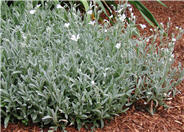
Common name:Snow-In-Summer
Botanical name:Cerastium tomentosum
Masses of snow white flowers cover this plant from late spring to early summer. Fine textured foliage is silvery grey. After flowering, shear back plant to encourage new foliage and for a tidy appearance. Over-head watering may cause the plant to "melt-out" in the center; over-watering, in general, causes the plant to die out over time. An attractive filler among other plants and rocks, and nice ground cover for areas that receive little foot traffic. Plant at edges of walks to soften paths. I saw a lovely planting where cerastium was used to represent water in a "dry creek" design-Brilliant. Grows 4 to 5 inches tall and 15 to 18 inches wide.
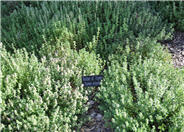
Common name:Mother-of-Thyme
Botanical name:Thymus serpyllum
Mother-of-thyme is a woody based perennial which is primarily used as a ground cover. Numerous, thin, somewhat woody stems form a low mat (2 to 3 inches tall and 12 or so inches across) with tiny, rounded, glossy blue-green leaves. Leaves are aromatic, though usually not considered to be of culinary quality. Clusters of tiny, tubular, deep pink flowers appear in summer. Flowers are attractive to bees. There are many cultivars with a more dependably low habit; the species is a bit taller and so is best used at the sides of walks of paths, or to edge a sunny border.
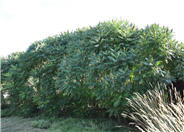
Common name:Smooth Sumac
Botanical name:Rhus glabra
Smooth sumac is a deciduous shrub with an open, irregular, spreading habit, typically growing 8 to 15 feet tall and wide (or wider). It spreads by root suckers to form thickets or large colonies. Very similar to staghorn sumac (R. typhina), except the young stems of staghorn are densely hairy whereas those of this species are smooth, hence the common name. Large, compound pinnate, shiny, dark green leaves grow with a long, fern-like appearance and turn attractive shades of bright orange to red in autumn. Tiny, yellowish-green flowers bloom in terminal panicles (5 to 10 inches long) in late spring to early summer, with separate male and female flowers appearing on separate plants. Female plants produce showy, erect, pyramidal fruiting clusters (to 8 inches long). Each cluster contains numerous hairy, berry-like drupes which ripen red in autumn, gradually turning maroon-brown as they persist through most of the winter. Fruit is attractive to wildlife. Mores a stricking architectural statement in the landscape.
| Designer: Rick Laughlin | Dymondia Pond 6 |
Photographer: GardenSoft |
Water Saving Tip:
Apply as little fertilizer as possible.
If you use fertilizer make sure it stays on the landscape, and carefully water it in so there is NO runoff.
